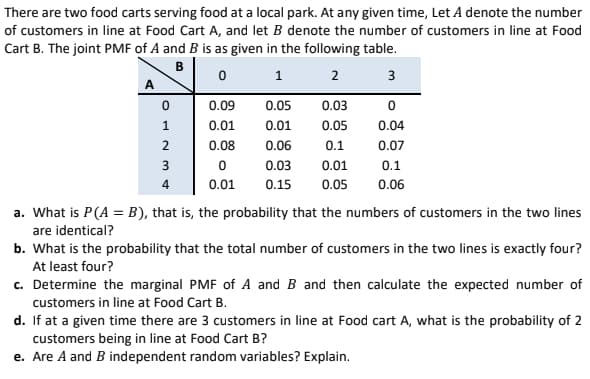Dark. Al any giv s in line at Food Cart A, and let B denote the number of customer oint PMF of A and B is as given in the following table. В 1 2 3 A 0.09 0.05 0.03 0.01 0.01 0.05 0.04 0.08 0.06 0.1 0.07 3 0.03 0.01 0.1 4 0.01 0.15 0.05 0.06 P(A = B), that is, the probability that the numbers of customers htical? the probability that the total number of customers in the two line four?
Dark. Al any giv s in line at Food Cart A, and let B denote the number of customer oint PMF of A and B is as given in the following table. В 1 2 3 A 0.09 0.05 0.03 0.01 0.01 0.05 0.04 0.08 0.06 0.1 0.07 3 0.03 0.01 0.1 4 0.01 0.15 0.05 0.06 P(A = B), that is, the probability that the numbers of customers htical? the probability that the total number of customers in the two line four?
Linear Algebra: A Modern Introduction
4th Edition
ISBN:9781285463247
Author:David Poole
Publisher:David Poole
Chapter2: Systems Of Linear Equations
Section2.4: Applications
Problem 1EQ: 1. Suppose that, in Example 2.27, 400 units of food A, 600 units of B, and 600 units of C are placed...
Related questions
Question

Transcribed Image Text:There are two food carts serving food at a local park. At any given time, Let A denote the number
of customers in line at Food Cart A, and let B denote the number of customers in line at Food
Cart B. The joint PMF of A and B is as given in the following table.
В
0 1
2
3
A
0.09
0.05
0.03
1
0.01
0.01
0.05
0.04
2
0.08
0.06
0.1
0.07
3
0.03
0.01
0.1
4
0.01
0.15
0.05
0.06
a. What is P(A = B), that is, the probability that the numbers of customers in the two lines
are identical?
b. What is the probability that the total number of customers in the two lines is exactly four?
At least four?
c. Determine the marginal PMF of A and B and then calculate the expected number of
customers in line at Food Cart B.
d. If at a given time there are 3 customers in line at Food cart A, what is the probability of 2
customers being in line at Food Cart B?
e. Are A and B independent random variables? Explain.
Expert Solution
This question has been solved!
Explore an expertly crafted, step-by-step solution for a thorough understanding of key concepts.
Step by step
Solved in 4 steps with 1 images

Recommended textbooks for you

Linear Algebra: A Modern Introduction
Algebra
ISBN:
9781285463247
Author:
David Poole
Publisher:
Cengage Learning

Linear Algebra: A Modern Introduction
Algebra
ISBN:
9781285463247
Author:
David Poole
Publisher:
Cengage Learning